Terry L. Ettinger Horticulture Consulting Services
Meeting The Needs Of Today With A Vision For The Future
Question of the Week
Crabgrass - or Tall Fescue?
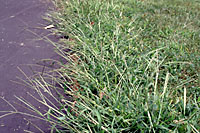 Q. Our problem is crabgrass. Even after applying a well-known brand of crabgrass killer in early April for the
past three years, we still have huge clumps of this nasty weed scattered throughout our lawn. In fact, the weed killer
doesn't appear to have had any effect at all! What are we doing wrong?
Q. Our problem is crabgrass. Even after applying a well-known brand of crabgrass killer in early April for the
past three years, we still have huge clumps of this nasty weed scattered throughout our lawn. In fact, the weed killer
doesn't appear to have had any effect at all! What are we doing wrong?
A. Without actually seeing these "clumps" of crabgrass, I can't offer you a one hundred percent accurate reply. I can, however, say with one hundred percent certainty that if you see crabgrass in your lawn in early April, you're not living in Central New York!
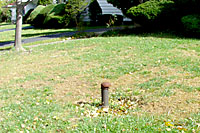 I say this because crabgrass plants are killed by the first hard
frosts each autumn - often leaving large dead patches in heavily infested
lawns, at left. Crabgrass seed, however, does survive over the winter and germinates after exposure to strong sunlight, adequate soil
moisture and soil temperatures above 55 degrees for about five consecutive days.
I say this because crabgrass plants are killed by the first hard
frosts each autumn - often leaving large dead patches in heavily infested
lawns, at left. Crabgrass seed, however, does survive over the winter and germinates after exposure to strong sunlight, adequate soil
moisture and soil temperatures above 55 degrees for about five consecutive days.
 Since the air temperature in Syracuse doesn't average above fifty
degrees until the last week in April, the soil is often not warm
enough to trigger crabgrass seed
germination until early May across much of Central New York. This means it could easily
be at least the middle of May before seedling crabgrass plants are easy to see,
above right.
Since the air temperature in Syracuse doesn't average above fifty
degrees until the last week in April, the soil is often not warm
enough to trigger crabgrass seed
germination until early May across much of Central New York. This means it could easily
be at least the middle of May before seedling crabgrass plants are easy to see,
above right.
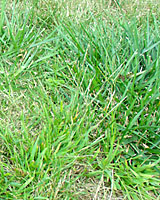 What you may be mistaking for crabgrass
might, instead, be large clumps of coarse-bladed tall fescue?
In the picture at left, the spiky, darker green leaves of tall
fescue can be seen in the upper right corner, while the lighter
green leaves of a clump of crabgrass is at the lower left.
What you may be mistaking for crabgrass
might, instead, be large clumps of coarse-bladed tall fescue?
In the picture at left, the spiky, darker green leaves of tall
fescue can be seen in the upper right corner, while the lighter
green leaves of a clump of crabgrass is at the lower left.
Looking very closely at the top surface of the leaves of the two
grasses, at right, you can see that the leaf blades of tall fescue
(right) are thick, dark green and
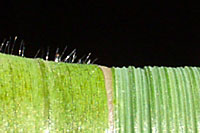 have
distinct ridges. Crabgrass leaf blades (left), are lighter green,
have no ridges and often have short hairs covering the leaf surface.
have
distinct ridges. Crabgrass leaf blades (left), are lighter green,
have no ridges and often have short hairs covering the leaf surface.
If this is a case of mistaken identity, it's easy to understand why the crabgrass herbicides you've applied for the past three years haven't improved the appearance of your lawn - they don't work against tall fescue!
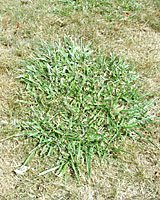 If your lawn is infested by large clumps of tall fescue
(at left), your only option is to kill the clumps - and the
surrounding desirable grasses - with a non-selective herbicide such as Roundup in mid-August. You can then overseed the dead
patches with a "sunny" or "shady" lawn mix of cool season grasses that more closely match the finer texture of the grasses
in your lawn during the last week in August.
If your lawn is infested by large clumps of tall fescue
(at left), your only option is to kill the clumps - and the
surrounding desirable grasses - with a non-selective herbicide such as Roundup in mid-August. You can then overseed the dead
patches with a "sunny" or "shady" lawn mix of cool season grasses that more closely match the finer texture of the grasses
in your lawn during the last week in August.
In a worst-case scenario you're best option may be to renovate your entire lawn in late August if more than fifty percent of it is made up of clumps of tall fescue, crabgrass and other weeds?
For more information on caring for your lawn, click here to go to the Lawn Care Introduction page on this website. From there you can download copies of my "Central New York Lawn Care and "Recommended Lawn Care Product" guides.